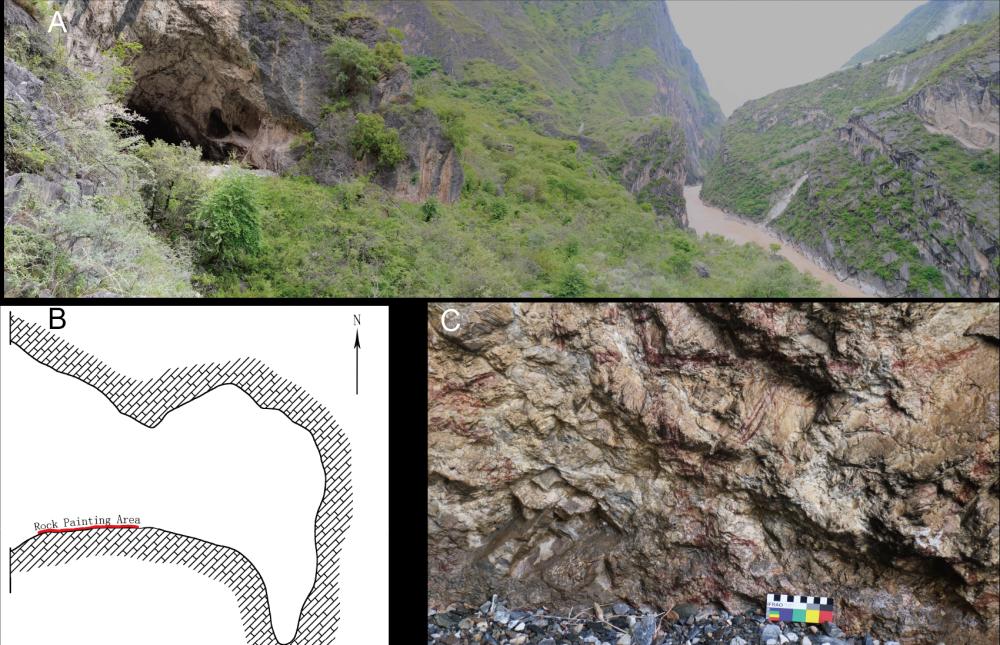Dating shows that the rock paintings of the Man-Man Cave in jinshajiang tiger leaping gorge in Lijiang City, Yunnan Province, dating from the late Pleistocene to the early Holocene, are the oldest painted petroglyphs in East Asia with dating data records, created by Paleolithic hunter-gatherers in the region. The research was recently published in the international archaeological journal Journal of Archaeological Sciences.

The picture shows the rock painting point of the Tiger Leaping Gorge Wanren Cave Provided by the Yunnan Provincial Institute of Cultural Relics and Archaeology
Located on the south bank of the Jinsha River Tiger Leaping Gorge Scenic Area, at an altitude of about 1681 meters, the petroglyphs in the cave are painted on the south wall near the mouth of the cave, and the colors range from purple red, red to orange red, and the content is mostly lines, most of which have been obscured. According to Wu Hu, the first author of the paper and a librarian at the Yunnan Institute of Cultural Relics and Archaeology, in July 2021, researchers collected 13 small samples of cave carbonate sediments directly related to petroglyph fragments at five sites on the south wall of the cave.
Dating through uranium dating, the researchers found that the Man-in-Man Cave could be accurately reconstructed in at least three mapping stages: 13580-13000, 10830-10540, and 8700-8370, from the end of the Late Pleistocene to the early Holocene, significantly earlier than the earliest farming eras in the region (about 4600 years ago). In addition, the collection of Information on Paleolithic artifacts shows that these petroglyphs were largely created by the Paleolithic hunter-gatherer population of the region.
The picture shows the carbonate sediments associated with petroglyphs Courtesy of the Institute of Cultural Relics and Archaeology of Yunnan Province
Wu Hu said that based on the development of high-precision uranium dating technology in recent years, the study for the first time gave clear evidence to support the dating of Jinshajiang petroglyphs dating back to the late Pleistocene to the early Holocene, indicating that jinshajiang petroglyphs are the earliest petroglyphs with absolute dating data in China and even in the entire East Asian region.
The Jinsha River petroglyphs were first discovered in 1988 and are among the most abundant of their kind in the world. Jinshajiang rock paintings mostly use depiction techniques, mainly realistic, showing images of bison, deer, rock sheep, wild horses, bears, tigers and other animals, accurate depiction, skillful penmanship, vivid form; in addition, there are characters, bows and arrows, handprints and abstract patterns. Zhang Yasha, director of the Chinese Rock Art Research Center of the Central University for Nationalities, said that the publication of the results has opened the prelude to the discovery and research of Paleolithic painted rock paintings in China with high-precision dating.
The picture shows the rock painting of the Tiger Leaping Gorge Wanren Cave provided by the Yunnan Provincial Institute of Cultural Relics and Archaeology
The research was cooperated by the Yunnan Institute of Cultural Relics and Archaeology with Nanjing Normal University, Wuhan University and other units, and was supported by the State Administration of Cultural Heritage and the National Natural Science Foundation of China. Since 2008, the research team has investigated and studied the petroglyphic heritage of the Jinsha River Basin, with Yulong County, Ninglang County and Shangri-La City of Diqing Tibetan Autonomous Prefecture as the core area, and placed it in the context of international petroglyph research and incorporated it into the regional prehistoric archaeological and cultural framework.
Reporter: Yan Yong